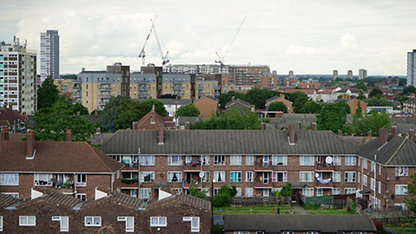Record numbers of us now commute by bike. How is this trend starting to influence cities and the built environment?
How about this for a cycle-to-work scheme? At the Alphabeta building in the City of London, employees commuting by bike can ride straight in off the street into the lobby, and glide down a custom-built ramp to a bike storage area. Once they have found a space among the 250 available, there are lockers and showers to use, and should their tyres need inflating or saddle adjusting, there is even a resident bike mechanic on hand. The 220,000 ft2 (20,440 m2) property, which was completed in 2015, was perhaps the UK’s first fully “cycle-in” office.
The cycle-in office is indicative of how cycling to work has become an established transport option for growing numbers of workers, as cities become more overcrowded and traffic congested. In London, cyclists account for 25% of all rush-hour road users and take twice as many daily journeys as they did in 2001, reports Transport for London (TfL).
At present, 1%-2% of all trips in the UK are made by bike, according to sustainable transport charity Sustrans. This is small compared with figures of 27% in the Netherlands, and even 10% in Germany. However, there is rising public demand for the British government to invest in making cycling safer and more accessible. In Sustrans’ Bike Life survey of 11,000 people in seven UK cities, 75% said they wanted much more money to be spent on cycling measures – about £26 per person, against the current £4 in England. This backing even came from 71% of non-bike riders.
“I always thought cycling in the Netherlands was more advanced because people only cycled short distances,” comments Matt Winfield, regional director for London at Sustrans. “However, this is not the case – many commutes are nine miles or more, so it is about building much better cycling infrastructure and having a greater sense of priority for cyclists.”
The demand for better cycling infrastructure is tied to an obvious correlation between bike commuting and people’s health, too. A University of Glasgow study found that cycling to work is associated with a 45% lower risk of developing cancer, a 46% lower risk of heart disease and a 41% lower risk of premature death, compared with a non-active commute. Companies could also reap benefits from health insurance savings for promoting bike commuting to workers.
With the right political will and investment, a large city can be reborn as a “cycling city”. In the mid-1970s, Copenhagen was beset by traffic problems until it underwent a radical rethink of how to introduce more cycling infrastructure. Urban planning consultancy Copenhagenize reports that around 45% of the city’s population now arrives at work or a place of education by bike, thanks to more than 600 miles (1,000 km) of cycle lanes in the Greater Copenhagen area. Cycling safety has also increased significantly as a result of infrastructure improvements, such as segregated bike lanes and intersections with dedicated traffic lights for cyclists. Further progress was made by regional bike planning that ties the whole network of bike lanes together across municipalities.
In Bogotá, Colombia, the radical shift from cars to other means of transport, and cycling in particular, is attributed to the city’s mayor Enrique Peñalosa, who declared in 1999: “A citizen on a $30 bicycle is equally important to one in a $30,000 car.” On taking office, Peñalosa scrapped plans for expensive, elevated motorways, and instead invested the money in cycle lanes and the bus network. Over the past 15 years, the city council has installed around 218 miles (350 km) of bike paths, and for every new street built, laws stipulate that it must include a bike lane.
Furthermore, Peñalosa’s urban transport plan has been recognised as an effective way to bring about a more socially just and sustainable city. More than 300,000 trips are made each day on bike paths running through wealthy and low-income areas, and every Sunday the capital closes more than 60 miles (100 km) of roads to motor vehicles, clearing the streets for up to two million people cycling.
“1-2% of all trips in the UK are made by bike. This is small compared with figures of 27% in the Netherlands, and even 10% in Germany.”
It is a similar story in Seville, Spain. Twelve years ago the Andalusian government took the decision to fast-track a cycling infrastructure plan in an effort to reduce the city’s horrendous traffic jams. Around 50 miles (80 km) of bike lanes were built within just a year, and a bike rental scheme established. Daily journeys by bike shot up from less than 0.5% to around 7%, despite the city having no tradition of commuter cycling and having one of Europe’s hotter climates.
With greater numbers of city dwellers preferring to cycle, and with office take-up driven by technology, media and telecoms (TMT) companies that tend to employ young, often bike-riding recruits, should more responsibility also lie with developers and landlords to build or retrofit high-quality cycling facilities?
“I think we’ve already reached a tipping point in London,” says Neil Webster MRICS, director of public sector asset management consultant Cyclo Consulting. “In many cases, landlords are having to increase bike facilities as part of company policy, or are choosing to anyway because the employee demand is there for more health-related infrastructure, such as cycling and gym facilities.” This was particularly true at the Alphabeta building, where the client decided the trade-off between the loss of net internal area and the cycle ramp was worth it.
Deloitte’s London Office Crane Survey Summer 2017 certainly bears out Webster’s views. The firm reports that 14,000 bike spaces are being built in office schemes that are currently under construction in the capital.
But beyond the eye-catching figures, it is clear there is still some work to do. Recent research carried out by Remit Consulting for the British Council for Offices found that although 83% of workplaces in the UK provide some form of bike storage, only 47% of this is covered and secure. And less than 45% of offices do not have showers. Webster is keen to stress that building greater cycling provision is also about holistically linking infrastructure from the home to the office. “There’s no point in making workplace changes if it’s unsafe to cycle between the two destinations.”
Gradually, though, London’s cycling infrastructure is being rethought on a grand scale. The most obvious example of this is the East-West Cycle Superhighway, an 18-mile segregated cycle lane running straight through the city.
While London sets out its own vision of becoming a cycling-friendly city, ultimately, along with increased investment, cycling needs to be seen to become far more “normalised” in cities. Webster believes Chris Boardman, the UK Olympic cycling champion, summed it up best. “He said: ‘In the Netherlands you don’t see cyclists – you just see ordinary people on bicycles.’ This is the mindset we need to get into.”













